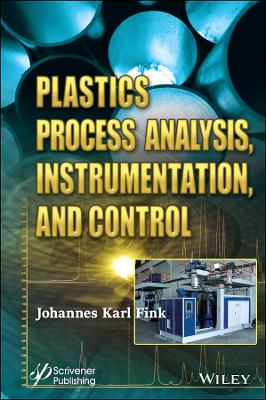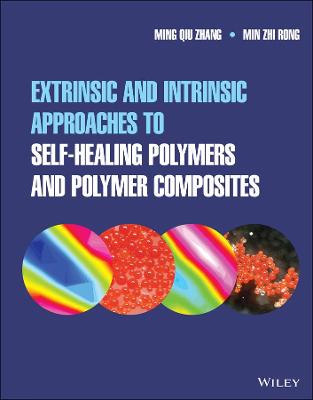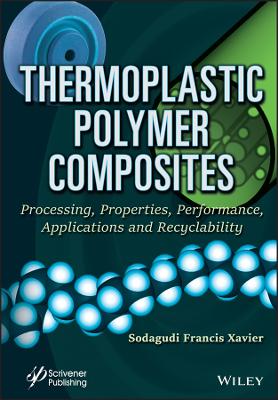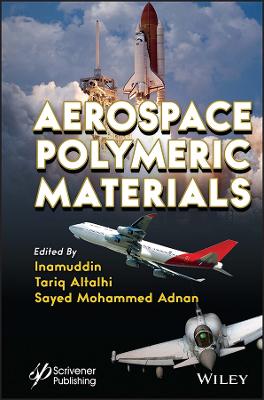Plastics Process Analysis, Instrumentation, and Control
 -15%
portes grátis
-15%
portes grátis
Plastics Process Analysis, Instrumentation, and Control
Fink, Johannes Karl
John Wiley & Sons Inc
04/2021
416
Dura
Inglês
9781119795735
15 a 20 dias
716
Descrição não disponível.
Preface i
1 General Aspects 1
1.1 Subjects of the Book 1
1.2 Special Issues 2
1.3 Injection Molding 3
1.3.1 Cost Estimation in Injection Molding 3
1.3.2 Cost Prediction Models 4
1.4 Miniature Molding Processes 6
1.5 Computer Determination of Weld Lines in Injection Molding 6
1.6 Extrusion Blow Molding 8
1.6.1 Rapid Thermal Cycling Molding 8
1.6.2 Rapid Heat Cycle Molding 8
1.6.3 Injection Molding: Heating 16
1.7 Microcellular Injection Molding 22
1.8 Mold Cooling 23
1.9 Microcellular Foam Processing System 27
1.9.1 Gas-Assisted Injection Molding 27
1.9.2 Water-Assisted Injection Molding 32
1.10 Molding Machine for Granules 32
1.11 Foam Curing of Footwear 33
1.12 Injection Compression Molding 35
1.13 Hot Press System 35
1.14 Stamper Mold 38
1.14.1 Recoding Media 38
1.14.2 Microscopic Structured Body 39
1.15 Plastic Waste 42
1.15.1 Marine Pollution 43
1.15.2 Human Health Effects 45
1.15.3 Recycling 45
References 57
2 Process Analysis 65
2.1 Concepts and Strategies 66
2.1.1 Chemometrics 67
2.1.2 Safety Risks 68
2.1.3 Feedback Procedures 68
2.2 Linear Systems 68
2.2.1 Simple First-Order Systems 68
2.2.2 Fractional Order Systems 69
2.2.3 Nonlinear Systems and Linearization 69
2.2.4 Characteristics of Systems 75
2.2.5 Controllers and Controller Settings 84
2.3 Twin-Screw Extrusion 91
References 92
3 Examples of Process Analysis 99
3.1 Greenhouse Gas Balance 99
3.1.1 Poly(ethylene furandicarboxylate) 99
3.1.2 Polyester Binder 100
3.2 Injection Molding Technology 101
3.2.1 Module for CAD Modeling of the Part 103
3.2.2 Module forNumerical Simulation of Injection Molding Process 104
3.2.3 Module for Calculation of Parameters of Injection Molding and Mold Design Calculation and Selection 105
3.2.4 Module for Mold Modeling 106
3.2.5 Examples of Testing 107
3.2.6 Molding Air Cooling 108
3.2.7 Cavity Pressure 109
3.2.8 Plastics Extruder Dynamics 110
3.2.9 History of Mathematical Modeling 110
3.2.10 Current Physical Components Concept 112
3.2.11 Process Stages 112
3.2.12 Data Envelopment Analysis 116
3.2.13 Taguchi Method 118
3.2.14 Tait Model 119
3.2.15 Phan-Thien-Tanner Model 121
3.2.16 Product Quality Prognosis 121
3.2.17 Production Predictive Control 122
3.2.18 Parameter Optimization for Energy Saving 123
3.2.19 Multilayer Control System 124
3.2.20 Smoothed Particle Hydrodynamics Method 125
3.2.21 Temperature-Dependent Adaptive Control 126
3.2.22 Micro-Injection Molding 128
3.2.23 Immiscible Polymer Blends 131
3.2.24 Resin Injection Molding 133
3.2.25 Foam Injection Molding 137
3.2.26 Self-Optimizing Injection Molding Process 138
3.2.27 Machine Setup 140
3.3 Shrinkage in Injection Molding 146
3.3.1 Factors that Affect the Shrinkage 146
3.3.2 Effect of a Cooling System 147
3.3.3 Influence of Molding Conditions on the Shrinkage and Roundness 148
3.3.4 Shear Viscosity 148
3.3.5 In-Situ Shrinkage Sensor 149
3.3.6 Semicrystalline Polymer 151
3.3.7 Thermoplastic Elastomers 151
3.3.8 Reprocessing of ABS 153
3.3.9 Sequential Simplex Algorithm with Automotive Ventiduct Grid 155
3.3.10 Taguchi, ANOVA, CAE, and Neural Network Methods 156
3.4 Recycling by Extrusion 166
3.4.1 Multiple In-Line Extruders 166
3.4.2 Mixed Post-Consumer Plastic Waste 167
3.4.3 Poly(methyl methacrylate) 168
3.4.4 Poly(ethylene terephthalate) 169
3.4.5 Poly(lactic acid) 169
3.4.6 Expanded Poly(styrene) 169
3.5 Batch Washing of Recycled Films 171
3.5.1 Recycling of Poly(styrene)Waste 171
3.5.2 Textile Finishing 172
3.5.3 Removing Scrap from Containers 173
3.5.4 Adsorption Isotherms and Desorption Rates 175
3.6 Self-Purging Microwave Pyrolysis 176
3.7 Purging and Plasticization in Injection Molding 177
3.7.1 Automatic Purging 177
3.8 Hot Runner Systems 179
3.8.1 Hot Runner Mold with Runner Pipe 180
3.8.2 Hot Runner System in Plastics Molding Tools 183
3.8.3 Manufacturing and Assembling of Hot Runner Systems 184
3.9 Blown Film Extrusion and Thickness Control 185
3.10 Residence Time Distribution for Biomass Pyrolysis 186
3.11 Reactive Extrusion 187
References 187
4 Process Instrumentation 201
4.1 In-Mold Measurement 201
4.2 Temperature 202
4.2.1 Soft Actuator 202
4.2.2 Thermocouples 202
4.2.3 Resistance Temperature Detectors 206
4.2.4 Thin Film Miniature Temperature Sensors 214
4.2.5 Neural Networks 214
4.3 Position Transducers 215
4.3.1 Rotary Position Transducer 215
4.3.2 Linear Variable Differential Transformers 216
4.3.3 Optical Encoders 218
4.3.4 Thickness Gauges 218
4.4 Composition of Matter 222
4.4.1 IR Interferometer for Multilayer Film 222
4.4.2 X-Ray Diffraction 225
4.4.3 Ion Mobility-Mass Spectrometry 226
4.4.4 Test for Ice Adhesion Strength 226
4.4.5 Piezoelectric Coaxial Filament Sensors 228
4.4.6 Instrumentation for Impact Testing 228
4.4.7 Treatment of Titanium Surfaces 229
4.4.8 Spatial Differentiation of Sub-Micrometer Domains 230
4.5 Medical Issues 231
4.5.1 Endoscopic Plastic Surgical Procedures 231
4.5.2 Medical Catheters 231
4.5.3 Multichannel Plastic Joint 237
4.5.4 Transluminal Endoscopic Surgery 238
4.5.5 Wire-Actuated Universal-Joint Wrists 238
4.5.6 Musculoskeletal Disorders 239
References 240
5 Actuators and Final Control Elements 245
5.1 Servo Valves 245
5.1.1 Nozzle Assembly for a Servo Valve 245
5.2 Servo Motors 248
5.2.1 Hydraulic System 248
5.2.2 Functionally Graded Materials 248
5.3 Solenoid Valves 251
5.3.1 Design Verification Methodology 251
5.3.2 Small Solenoid Valve 252
5.3.3 High-Speed Solenoid Valve 252
5.3.4 Numerical Simulation 252
5.4 Heaters 253
5.4.1 Conduction Heaters 253
5.4.2 Radiant Heaters 255
5.4.3 Heater Controls 255
5.5 Drive Motors and Motor Speed Control for Extrusion 256
5.5.1 Single-Drive Motor 256
5.5.2 Linear Induction Motor 256
5.5.3 Motor Power Consumption in Single-Screw Extrusion 257
5.5.4 Dual Motor Multi-Head 3D Printer 258
References 258
6 Analysis of Melt Processing Systems 261
6.1 Process Parameter Determination of Plastic Injection Molding 261
6.1.1 Case-Based Reasoning Method 261
6.1.2 Knowledge-Based Reasoning Method 264
6.1.3 Rule-Based Reasoning Method 265
6.1.4 Fuzzy Reasoning Method 266
6.2 Process Parameter Determination of Plastic Injection Molding of LCDs 267
6.3 Processing History 267
6.3.1 Flow Defects 267
6.3.2 Biocomposites 269
6.3.3 3D Printing 271
6.3.4 Semiconducting Polymer Blends 272
6.3.5 Van Gurp-Palmen Plot 272
6.3.6 Nanocrystal Composites 273
6.3.7 Melt-Mastication 274
6.3.8 Crystal Nucleation in Nanocomposites 275
6.4 Shear History 276
6.5 Extrusion Product Control 278
6.5.1 Branched Structures 278
6.5.2 Big Area Additive Manufacturing 279
6.5.3 Single-Screw Extrusion Control 280
6.5.4 Blown Film 284
6.5.5 Chill Roll Cast Film 285
6.5.6 Sheet 292
6.5.7 Profiles 294
6.5.8 Pipe and Tubing 297
6.5.9 Automatic Screen Changers 303
6.6 Extrusion Blow Molding Parison Control 306
6.7 Injection Molding 310
6.7.1 Ram Velocity Control 310
6.7.2 Pressure Control 313
6.7.3 Gas-Assisted Control 319
6.7.4 System Diagnostics 322
6.7.5 Statistical Process and Quality Control 328
6.8 Thermoforming 329
6.8.1 Twin Sheet Thermoforming 329
6.8.2 Rotary Thermoforming 330
6.8.3 Process Model for Thermoforming 331
6.9 Rotomolding 332
6.9.1 Polymer Compositions for Rotomolding 334
6.10 Compounders 348
6.10.1 History of Compounding 348
6.10.2 Types of Compounders 348
6.10.3 Special Applications 350
References 352
7 Auxiliary Equipment 363
7.1 Crammer Feeder 363
7.1.1 Crammer Feeder for Extruder 363
7.1.2 Devulcanization of Scrap Rubber 363
7.2 Dryers 364
7.2.1 Drying Temperatures 364
7.2.2 Moisture Content 366
7.2.3 Resin Dryers 366
7.2.4 Pellet Dryers 369
7.3 Pullers 379
7.3.1 Pullers in Extrusion 379
7.3.2 Pullers in Injection Molding 381
7.4 Chillers 384
7.5 Robots 385
References 387
Index 389
Acronyms 389
Chemicals 394
General Index 399
1 General Aspects 1
1.1 Subjects of the Book 1
1.2 Special Issues 2
1.3 Injection Molding 3
1.3.1 Cost Estimation in Injection Molding 3
1.3.2 Cost Prediction Models 4
1.4 Miniature Molding Processes 6
1.5 Computer Determination of Weld Lines in Injection Molding 6
1.6 Extrusion Blow Molding 8
1.6.1 Rapid Thermal Cycling Molding 8
1.6.2 Rapid Heat Cycle Molding 8
1.6.3 Injection Molding: Heating 16
1.7 Microcellular Injection Molding 22
1.8 Mold Cooling 23
1.9 Microcellular Foam Processing System 27
1.9.1 Gas-Assisted Injection Molding 27
1.9.2 Water-Assisted Injection Molding 32
1.10 Molding Machine for Granules 32
1.11 Foam Curing of Footwear 33
1.12 Injection Compression Molding 35
1.13 Hot Press System 35
1.14 Stamper Mold 38
1.14.1 Recoding Media 38
1.14.2 Microscopic Structured Body 39
1.15 Plastic Waste 42
1.15.1 Marine Pollution 43
1.15.2 Human Health Effects 45
1.15.3 Recycling 45
References 57
2 Process Analysis 65
2.1 Concepts and Strategies 66
2.1.1 Chemometrics 67
2.1.2 Safety Risks 68
2.1.3 Feedback Procedures 68
2.2 Linear Systems 68
2.2.1 Simple First-Order Systems 68
2.2.2 Fractional Order Systems 69
2.2.3 Nonlinear Systems and Linearization 69
2.2.4 Characteristics of Systems 75
2.2.5 Controllers and Controller Settings 84
2.3 Twin-Screw Extrusion 91
References 92
3 Examples of Process Analysis 99
3.1 Greenhouse Gas Balance 99
3.1.1 Poly(ethylene furandicarboxylate) 99
3.1.2 Polyester Binder 100
3.2 Injection Molding Technology 101
3.2.1 Module for CAD Modeling of the Part 103
3.2.2 Module forNumerical Simulation of Injection Molding Process 104
3.2.3 Module for Calculation of Parameters of Injection Molding and Mold Design Calculation and Selection 105
3.2.4 Module for Mold Modeling 106
3.2.5 Examples of Testing 107
3.2.6 Molding Air Cooling 108
3.2.7 Cavity Pressure 109
3.2.8 Plastics Extruder Dynamics 110
3.2.9 History of Mathematical Modeling 110
3.2.10 Current Physical Components Concept 112
3.2.11 Process Stages 112
3.2.12 Data Envelopment Analysis 116
3.2.13 Taguchi Method 118
3.2.14 Tait Model 119
3.2.15 Phan-Thien-Tanner Model 121
3.2.16 Product Quality Prognosis 121
3.2.17 Production Predictive Control 122
3.2.18 Parameter Optimization for Energy Saving 123
3.2.19 Multilayer Control System 124
3.2.20 Smoothed Particle Hydrodynamics Method 125
3.2.21 Temperature-Dependent Adaptive Control 126
3.2.22 Micro-Injection Molding 128
3.2.23 Immiscible Polymer Blends 131
3.2.24 Resin Injection Molding 133
3.2.25 Foam Injection Molding 137
3.2.26 Self-Optimizing Injection Molding Process 138
3.2.27 Machine Setup 140
3.3 Shrinkage in Injection Molding 146
3.3.1 Factors that Affect the Shrinkage 146
3.3.2 Effect of a Cooling System 147
3.3.3 Influence of Molding Conditions on the Shrinkage and Roundness 148
3.3.4 Shear Viscosity 148
3.3.5 In-Situ Shrinkage Sensor 149
3.3.6 Semicrystalline Polymer 151
3.3.7 Thermoplastic Elastomers 151
3.3.8 Reprocessing of ABS 153
3.3.9 Sequential Simplex Algorithm with Automotive Ventiduct Grid 155
3.3.10 Taguchi, ANOVA, CAE, and Neural Network Methods 156
3.4 Recycling by Extrusion 166
3.4.1 Multiple In-Line Extruders 166
3.4.2 Mixed Post-Consumer Plastic Waste 167
3.4.3 Poly(methyl methacrylate) 168
3.4.4 Poly(ethylene terephthalate) 169
3.4.5 Poly(lactic acid) 169
3.4.6 Expanded Poly(styrene) 169
3.5 Batch Washing of Recycled Films 171
3.5.1 Recycling of Poly(styrene)Waste 171
3.5.2 Textile Finishing 172
3.5.3 Removing Scrap from Containers 173
3.5.4 Adsorption Isotherms and Desorption Rates 175
3.6 Self-Purging Microwave Pyrolysis 176
3.7 Purging and Plasticization in Injection Molding 177
3.7.1 Automatic Purging 177
3.8 Hot Runner Systems 179
3.8.1 Hot Runner Mold with Runner Pipe 180
3.8.2 Hot Runner System in Plastics Molding Tools 183
3.8.3 Manufacturing and Assembling of Hot Runner Systems 184
3.9 Blown Film Extrusion and Thickness Control 185
3.10 Residence Time Distribution for Biomass Pyrolysis 186
3.11 Reactive Extrusion 187
References 187
4 Process Instrumentation 201
4.1 In-Mold Measurement 201
4.2 Temperature 202
4.2.1 Soft Actuator 202
4.2.2 Thermocouples 202
4.2.3 Resistance Temperature Detectors 206
4.2.4 Thin Film Miniature Temperature Sensors 214
4.2.5 Neural Networks 214
4.3 Position Transducers 215
4.3.1 Rotary Position Transducer 215
4.3.2 Linear Variable Differential Transformers 216
4.3.3 Optical Encoders 218
4.3.4 Thickness Gauges 218
4.4 Composition of Matter 222
4.4.1 IR Interferometer for Multilayer Film 222
4.4.2 X-Ray Diffraction 225
4.4.3 Ion Mobility-Mass Spectrometry 226
4.4.4 Test for Ice Adhesion Strength 226
4.4.5 Piezoelectric Coaxial Filament Sensors 228
4.4.6 Instrumentation for Impact Testing 228
4.4.7 Treatment of Titanium Surfaces 229
4.4.8 Spatial Differentiation of Sub-Micrometer Domains 230
4.5 Medical Issues 231
4.5.1 Endoscopic Plastic Surgical Procedures 231
4.5.2 Medical Catheters 231
4.5.3 Multichannel Plastic Joint 237
4.5.4 Transluminal Endoscopic Surgery 238
4.5.5 Wire-Actuated Universal-Joint Wrists 238
4.5.6 Musculoskeletal Disorders 239
References 240
5 Actuators and Final Control Elements 245
5.1 Servo Valves 245
5.1.1 Nozzle Assembly for a Servo Valve 245
5.2 Servo Motors 248
5.2.1 Hydraulic System 248
5.2.2 Functionally Graded Materials 248
5.3 Solenoid Valves 251
5.3.1 Design Verification Methodology 251
5.3.2 Small Solenoid Valve 252
5.3.3 High-Speed Solenoid Valve 252
5.3.4 Numerical Simulation 252
5.4 Heaters 253
5.4.1 Conduction Heaters 253
5.4.2 Radiant Heaters 255
5.4.3 Heater Controls 255
5.5 Drive Motors and Motor Speed Control for Extrusion 256
5.5.1 Single-Drive Motor 256
5.5.2 Linear Induction Motor 256
5.5.3 Motor Power Consumption in Single-Screw Extrusion 257
5.5.4 Dual Motor Multi-Head 3D Printer 258
References 258
6 Analysis of Melt Processing Systems 261
6.1 Process Parameter Determination of Plastic Injection Molding 261
6.1.1 Case-Based Reasoning Method 261
6.1.2 Knowledge-Based Reasoning Method 264
6.1.3 Rule-Based Reasoning Method 265
6.1.4 Fuzzy Reasoning Method 266
6.2 Process Parameter Determination of Plastic Injection Molding of LCDs 267
6.3 Processing History 267
6.3.1 Flow Defects 267
6.3.2 Biocomposites 269
6.3.3 3D Printing 271
6.3.4 Semiconducting Polymer Blends 272
6.3.5 Van Gurp-Palmen Plot 272
6.3.6 Nanocrystal Composites 273
6.3.7 Melt-Mastication 274
6.3.8 Crystal Nucleation in Nanocomposites 275
6.4 Shear History 276
6.5 Extrusion Product Control 278
6.5.1 Branched Structures 278
6.5.2 Big Area Additive Manufacturing 279
6.5.3 Single-Screw Extrusion Control 280
6.5.4 Blown Film 284
6.5.5 Chill Roll Cast Film 285
6.5.6 Sheet 292
6.5.7 Profiles 294
6.5.8 Pipe and Tubing 297
6.5.9 Automatic Screen Changers 303
6.6 Extrusion Blow Molding Parison Control 306
6.7 Injection Molding 310
6.7.1 Ram Velocity Control 310
6.7.2 Pressure Control 313
6.7.3 Gas-Assisted Control 319
6.7.4 System Diagnostics 322
6.7.5 Statistical Process and Quality Control 328
6.8 Thermoforming 329
6.8.1 Twin Sheet Thermoforming 329
6.8.2 Rotary Thermoforming 330
6.8.3 Process Model for Thermoforming 331
6.9 Rotomolding 332
6.9.1 Polymer Compositions for Rotomolding 334
6.10 Compounders 348
6.10.1 History of Compounding 348
6.10.2 Types of Compounders 348
6.10.3 Special Applications 350
References 352
7 Auxiliary Equipment 363
7.1 Crammer Feeder 363
7.1.1 Crammer Feeder for Extruder 363
7.1.2 Devulcanization of Scrap Rubber 363
7.2 Dryers 364
7.2.1 Drying Temperatures 364
7.2.2 Moisture Content 366
7.2.3 Resin Dryers 366
7.2.4 Pellet Dryers 369
7.3 Pullers 379
7.3.1 Pullers in Extrusion 379
7.3.2 Pullers in Injection Molding 381
7.4 Chillers 384
7.5 Robots 385
References 387
Index 389
Acronyms 389
Chemicals 394
General Index 399
Este título pertence ao(s) assunto(s) indicados(s). Para ver outros títulos clique no assunto desejado.
<p>Hot embossing</p> <p> Hot-melt extrusion</p> <p> Hydrocracking</p> <p> Hydrocyclone</p> <p> Hydrogel biomaterials</p> <p> Hyperbranched polymer</p> <p> Immunosorbent assays</p> <p> Impact-extrusion</p> <p> Incineration</p> <p> Incompressible fluid flow</p> <p> Induction heating</p> <p> Injection molding engine</p> <p> LISREL model</p> <p> Microplastic toxicity</p> <p> Microwave pyrolysis</p> <p> Additive manufacturing</p> <p> Aerospace</p> <p> Agglomeration apparatus</p> <p> Centrifugal pellet dryers</p> <p> Co-rotating extruder</p> <p> Compatibilizer</p> <p> Induction heating</p> <p> Injection-blow molding</p> <p> Injection-compression molding</p> <p> Laser heating</p> <p> Microcellular injection molding</p> <p> Piezoelectric sensors</p> <p> Rapid heat cycle molding</p> <p> </p>
Preface i
1 General Aspects 1
1.1 Subjects of the Book 1
1.2 Special Issues 2
1.3 Injection Molding 3
1.3.1 Cost Estimation in Injection Molding 3
1.3.2 Cost Prediction Models 4
1.4 Miniature Molding Processes 6
1.5 Computer Determination of Weld Lines in Injection Molding 6
1.6 Extrusion Blow Molding 8
1.6.1 Rapid Thermal Cycling Molding 8
1.6.2 Rapid Heat Cycle Molding 8
1.6.3 Injection Molding: Heating 16
1.7 Microcellular Injection Molding 22
1.8 Mold Cooling 23
1.9 Microcellular Foam Processing System 27
1.9.1 Gas-Assisted Injection Molding 27
1.9.2 Water-Assisted Injection Molding 32
1.10 Molding Machine for Granules 32
1.11 Foam Curing of Footwear 33
1.12 Injection Compression Molding 35
1.13 Hot Press System 35
1.14 Stamper Mold 38
1.14.1 Recoding Media 38
1.14.2 Microscopic Structured Body 39
1.15 Plastic Waste 42
1.15.1 Marine Pollution 43
1.15.2 Human Health Effects 45
1.15.3 Recycling 45
References 57
2 Process Analysis 65
2.1 Concepts and Strategies 66
2.1.1 Chemometrics 67
2.1.2 Safety Risks 68
2.1.3 Feedback Procedures 68
2.2 Linear Systems 68
2.2.1 Simple First-Order Systems 68
2.2.2 Fractional Order Systems 69
2.2.3 Nonlinear Systems and Linearization 69
2.2.4 Characteristics of Systems 75
2.2.5 Controllers and Controller Settings 84
2.3 Twin-Screw Extrusion 91
References 92
3 Examples of Process Analysis 99
3.1 Greenhouse Gas Balance 99
3.1.1 Poly(ethylene furandicarboxylate) 99
3.1.2 Polyester Binder 100
3.2 Injection Molding Technology 101
3.2.1 Module for CAD Modeling of the Part 103
3.2.2 Module forNumerical Simulation of Injection Molding Process 104
3.2.3 Module for Calculation of Parameters of Injection Molding and Mold Design Calculation and Selection 105
3.2.4 Module for Mold Modeling 106
3.2.5 Examples of Testing 107
3.2.6 Molding Air Cooling 108
3.2.7 Cavity Pressure 109
3.2.8 Plastics Extruder Dynamics 110
3.2.9 History of Mathematical Modeling 110
3.2.10 Current Physical Components Concept 112
3.2.11 Process Stages 112
3.2.12 Data Envelopment Analysis 116
3.2.13 Taguchi Method 118
3.2.14 Tait Model 119
3.2.15 Phan-Thien-Tanner Model 121
3.2.16 Product Quality Prognosis 121
3.2.17 Production Predictive Control 122
3.2.18 Parameter Optimization for Energy Saving 123
3.2.19 Multilayer Control System 124
3.2.20 Smoothed Particle Hydrodynamics Method 125
3.2.21 Temperature-Dependent Adaptive Control 126
3.2.22 Micro-Injection Molding 128
3.2.23 Immiscible Polymer Blends 131
3.2.24 Resin Injection Molding 133
3.2.25 Foam Injection Molding 137
3.2.26 Self-Optimizing Injection Molding Process 138
3.2.27 Machine Setup 140
3.3 Shrinkage in Injection Molding 146
3.3.1 Factors that Affect the Shrinkage 146
3.3.2 Effect of a Cooling System 147
3.3.3 Influence of Molding Conditions on the Shrinkage and Roundness 148
3.3.4 Shear Viscosity 148
3.3.5 In-Situ Shrinkage Sensor 149
3.3.6 Semicrystalline Polymer 151
3.3.7 Thermoplastic Elastomers 151
3.3.8 Reprocessing of ABS 153
3.3.9 Sequential Simplex Algorithm with Automotive Ventiduct Grid 155
3.3.10 Taguchi, ANOVA, CAE, and Neural Network Methods 156
3.4 Recycling by Extrusion 166
3.4.1 Multiple In-Line Extruders 166
3.4.2 Mixed Post-Consumer Plastic Waste 167
3.4.3 Poly(methyl methacrylate) 168
3.4.4 Poly(ethylene terephthalate) 169
3.4.5 Poly(lactic acid) 169
3.4.6 Expanded Poly(styrene) 169
3.5 Batch Washing of Recycled Films 171
3.5.1 Recycling of Poly(styrene)Waste 171
3.5.2 Textile Finishing 172
3.5.3 Removing Scrap from Containers 173
3.5.4 Adsorption Isotherms and Desorption Rates 175
3.6 Self-Purging Microwave Pyrolysis 176
3.7 Purging and Plasticization in Injection Molding 177
3.7.1 Automatic Purging 177
3.8 Hot Runner Systems 179
3.8.1 Hot Runner Mold with Runner Pipe 180
3.8.2 Hot Runner System in Plastics Molding Tools 183
3.8.3 Manufacturing and Assembling of Hot Runner Systems 184
3.9 Blown Film Extrusion and Thickness Control 185
3.10 Residence Time Distribution for Biomass Pyrolysis 186
3.11 Reactive Extrusion 187
References 187
4 Process Instrumentation 201
4.1 In-Mold Measurement 201
4.2 Temperature 202
4.2.1 Soft Actuator 202
4.2.2 Thermocouples 202
4.2.3 Resistance Temperature Detectors 206
4.2.4 Thin Film Miniature Temperature Sensors 214
4.2.5 Neural Networks 214
4.3 Position Transducers 215
4.3.1 Rotary Position Transducer 215
4.3.2 Linear Variable Differential Transformers 216
4.3.3 Optical Encoders 218
4.3.4 Thickness Gauges 218
4.4 Composition of Matter 222
4.4.1 IR Interferometer for Multilayer Film 222
4.4.2 X-Ray Diffraction 225
4.4.3 Ion Mobility-Mass Spectrometry 226
4.4.4 Test for Ice Adhesion Strength 226
4.4.5 Piezoelectric Coaxial Filament Sensors 228
4.4.6 Instrumentation for Impact Testing 228
4.4.7 Treatment of Titanium Surfaces 229
4.4.8 Spatial Differentiation of Sub-Micrometer Domains 230
4.5 Medical Issues 231
4.5.1 Endoscopic Plastic Surgical Procedures 231
4.5.2 Medical Catheters 231
4.5.3 Multichannel Plastic Joint 237
4.5.4 Transluminal Endoscopic Surgery 238
4.5.5 Wire-Actuated Universal-Joint Wrists 238
4.5.6 Musculoskeletal Disorders 239
References 240
5 Actuators and Final Control Elements 245
5.1 Servo Valves 245
5.1.1 Nozzle Assembly for a Servo Valve 245
5.2 Servo Motors 248
5.2.1 Hydraulic System 248
5.2.2 Functionally Graded Materials 248
5.3 Solenoid Valves 251
5.3.1 Design Verification Methodology 251
5.3.2 Small Solenoid Valve 252
5.3.3 High-Speed Solenoid Valve 252
5.3.4 Numerical Simulation 252
5.4 Heaters 253
5.4.1 Conduction Heaters 253
5.4.2 Radiant Heaters 255
5.4.3 Heater Controls 255
5.5 Drive Motors and Motor Speed Control for Extrusion 256
5.5.1 Single-Drive Motor 256
5.5.2 Linear Induction Motor 256
5.5.3 Motor Power Consumption in Single-Screw Extrusion 257
5.5.4 Dual Motor Multi-Head 3D Printer 258
References 258
6 Analysis of Melt Processing Systems 261
6.1 Process Parameter Determination of Plastic Injection Molding 261
6.1.1 Case-Based Reasoning Method 261
6.1.2 Knowledge-Based Reasoning Method 264
6.1.3 Rule-Based Reasoning Method 265
6.1.4 Fuzzy Reasoning Method 266
6.2 Process Parameter Determination of Plastic Injection Molding of LCDs 267
6.3 Processing History 267
6.3.1 Flow Defects 267
6.3.2 Biocomposites 269
6.3.3 3D Printing 271
6.3.4 Semiconducting Polymer Blends 272
6.3.5 Van Gurp-Palmen Plot 272
6.3.6 Nanocrystal Composites 273
6.3.7 Melt-Mastication 274
6.3.8 Crystal Nucleation in Nanocomposites 275
6.4 Shear History 276
6.5 Extrusion Product Control 278
6.5.1 Branched Structures 278
6.5.2 Big Area Additive Manufacturing 279
6.5.3 Single-Screw Extrusion Control 280
6.5.4 Blown Film 284
6.5.5 Chill Roll Cast Film 285
6.5.6 Sheet 292
6.5.7 Profiles 294
6.5.8 Pipe and Tubing 297
6.5.9 Automatic Screen Changers 303
6.6 Extrusion Blow Molding Parison Control 306
6.7 Injection Molding 310
6.7.1 Ram Velocity Control 310
6.7.2 Pressure Control 313
6.7.3 Gas-Assisted Control 319
6.7.4 System Diagnostics 322
6.7.5 Statistical Process and Quality Control 328
6.8 Thermoforming 329
6.8.1 Twin Sheet Thermoforming 329
6.8.2 Rotary Thermoforming 330
6.8.3 Process Model for Thermoforming 331
6.9 Rotomolding 332
6.9.1 Polymer Compositions for Rotomolding 334
6.10 Compounders 348
6.10.1 History of Compounding 348
6.10.2 Types of Compounders 348
6.10.3 Special Applications 350
References 352
7 Auxiliary Equipment 363
7.1 Crammer Feeder 363
7.1.1 Crammer Feeder for Extruder 363
7.1.2 Devulcanization of Scrap Rubber 363
7.2 Dryers 364
7.2.1 Drying Temperatures 364
7.2.2 Moisture Content 366
7.2.3 Resin Dryers 366
7.2.4 Pellet Dryers 369
7.3 Pullers 379
7.3.1 Pullers in Extrusion 379
7.3.2 Pullers in Injection Molding 381
7.4 Chillers 384
7.5 Robots 385
References 387
Index 389
Acronyms 389
Chemicals 394
General Index 399
1 General Aspects 1
1.1 Subjects of the Book 1
1.2 Special Issues 2
1.3 Injection Molding 3
1.3.1 Cost Estimation in Injection Molding 3
1.3.2 Cost Prediction Models 4
1.4 Miniature Molding Processes 6
1.5 Computer Determination of Weld Lines in Injection Molding 6
1.6 Extrusion Blow Molding 8
1.6.1 Rapid Thermal Cycling Molding 8
1.6.2 Rapid Heat Cycle Molding 8
1.6.3 Injection Molding: Heating 16
1.7 Microcellular Injection Molding 22
1.8 Mold Cooling 23
1.9 Microcellular Foam Processing System 27
1.9.1 Gas-Assisted Injection Molding 27
1.9.2 Water-Assisted Injection Molding 32
1.10 Molding Machine for Granules 32
1.11 Foam Curing of Footwear 33
1.12 Injection Compression Molding 35
1.13 Hot Press System 35
1.14 Stamper Mold 38
1.14.1 Recoding Media 38
1.14.2 Microscopic Structured Body 39
1.15 Plastic Waste 42
1.15.1 Marine Pollution 43
1.15.2 Human Health Effects 45
1.15.3 Recycling 45
References 57
2 Process Analysis 65
2.1 Concepts and Strategies 66
2.1.1 Chemometrics 67
2.1.2 Safety Risks 68
2.1.3 Feedback Procedures 68
2.2 Linear Systems 68
2.2.1 Simple First-Order Systems 68
2.2.2 Fractional Order Systems 69
2.2.3 Nonlinear Systems and Linearization 69
2.2.4 Characteristics of Systems 75
2.2.5 Controllers and Controller Settings 84
2.3 Twin-Screw Extrusion 91
References 92
3 Examples of Process Analysis 99
3.1 Greenhouse Gas Balance 99
3.1.1 Poly(ethylene furandicarboxylate) 99
3.1.2 Polyester Binder 100
3.2 Injection Molding Technology 101
3.2.1 Module for CAD Modeling of the Part 103
3.2.2 Module forNumerical Simulation of Injection Molding Process 104
3.2.3 Module for Calculation of Parameters of Injection Molding and Mold Design Calculation and Selection 105
3.2.4 Module for Mold Modeling 106
3.2.5 Examples of Testing 107
3.2.6 Molding Air Cooling 108
3.2.7 Cavity Pressure 109
3.2.8 Plastics Extruder Dynamics 110
3.2.9 History of Mathematical Modeling 110
3.2.10 Current Physical Components Concept 112
3.2.11 Process Stages 112
3.2.12 Data Envelopment Analysis 116
3.2.13 Taguchi Method 118
3.2.14 Tait Model 119
3.2.15 Phan-Thien-Tanner Model 121
3.2.16 Product Quality Prognosis 121
3.2.17 Production Predictive Control 122
3.2.18 Parameter Optimization for Energy Saving 123
3.2.19 Multilayer Control System 124
3.2.20 Smoothed Particle Hydrodynamics Method 125
3.2.21 Temperature-Dependent Adaptive Control 126
3.2.22 Micro-Injection Molding 128
3.2.23 Immiscible Polymer Blends 131
3.2.24 Resin Injection Molding 133
3.2.25 Foam Injection Molding 137
3.2.26 Self-Optimizing Injection Molding Process 138
3.2.27 Machine Setup 140
3.3 Shrinkage in Injection Molding 146
3.3.1 Factors that Affect the Shrinkage 146
3.3.2 Effect of a Cooling System 147
3.3.3 Influence of Molding Conditions on the Shrinkage and Roundness 148
3.3.4 Shear Viscosity 148
3.3.5 In-Situ Shrinkage Sensor 149
3.3.6 Semicrystalline Polymer 151
3.3.7 Thermoplastic Elastomers 151
3.3.8 Reprocessing of ABS 153
3.3.9 Sequential Simplex Algorithm with Automotive Ventiduct Grid 155
3.3.10 Taguchi, ANOVA, CAE, and Neural Network Methods 156
3.4 Recycling by Extrusion 166
3.4.1 Multiple In-Line Extruders 166
3.4.2 Mixed Post-Consumer Plastic Waste 167
3.4.3 Poly(methyl methacrylate) 168
3.4.4 Poly(ethylene terephthalate) 169
3.4.5 Poly(lactic acid) 169
3.4.6 Expanded Poly(styrene) 169
3.5 Batch Washing of Recycled Films 171
3.5.1 Recycling of Poly(styrene)Waste 171
3.5.2 Textile Finishing 172
3.5.3 Removing Scrap from Containers 173
3.5.4 Adsorption Isotherms and Desorption Rates 175
3.6 Self-Purging Microwave Pyrolysis 176
3.7 Purging and Plasticization in Injection Molding 177
3.7.1 Automatic Purging 177
3.8 Hot Runner Systems 179
3.8.1 Hot Runner Mold with Runner Pipe 180
3.8.2 Hot Runner System in Plastics Molding Tools 183
3.8.3 Manufacturing and Assembling of Hot Runner Systems 184
3.9 Blown Film Extrusion and Thickness Control 185
3.10 Residence Time Distribution for Biomass Pyrolysis 186
3.11 Reactive Extrusion 187
References 187
4 Process Instrumentation 201
4.1 In-Mold Measurement 201
4.2 Temperature 202
4.2.1 Soft Actuator 202
4.2.2 Thermocouples 202
4.2.3 Resistance Temperature Detectors 206
4.2.4 Thin Film Miniature Temperature Sensors 214
4.2.5 Neural Networks 214
4.3 Position Transducers 215
4.3.1 Rotary Position Transducer 215
4.3.2 Linear Variable Differential Transformers 216
4.3.3 Optical Encoders 218
4.3.4 Thickness Gauges 218
4.4 Composition of Matter 222
4.4.1 IR Interferometer for Multilayer Film 222
4.4.2 X-Ray Diffraction 225
4.4.3 Ion Mobility-Mass Spectrometry 226
4.4.4 Test for Ice Adhesion Strength 226
4.4.5 Piezoelectric Coaxial Filament Sensors 228
4.4.6 Instrumentation for Impact Testing 228
4.4.7 Treatment of Titanium Surfaces 229
4.4.8 Spatial Differentiation of Sub-Micrometer Domains 230
4.5 Medical Issues 231
4.5.1 Endoscopic Plastic Surgical Procedures 231
4.5.2 Medical Catheters 231
4.5.3 Multichannel Plastic Joint 237
4.5.4 Transluminal Endoscopic Surgery 238
4.5.5 Wire-Actuated Universal-Joint Wrists 238
4.5.6 Musculoskeletal Disorders 239
References 240
5 Actuators and Final Control Elements 245
5.1 Servo Valves 245
5.1.1 Nozzle Assembly for a Servo Valve 245
5.2 Servo Motors 248
5.2.1 Hydraulic System 248
5.2.2 Functionally Graded Materials 248
5.3 Solenoid Valves 251
5.3.1 Design Verification Methodology 251
5.3.2 Small Solenoid Valve 252
5.3.3 High-Speed Solenoid Valve 252
5.3.4 Numerical Simulation 252
5.4 Heaters 253
5.4.1 Conduction Heaters 253
5.4.2 Radiant Heaters 255
5.4.3 Heater Controls 255
5.5 Drive Motors and Motor Speed Control for Extrusion 256
5.5.1 Single-Drive Motor 256
5.5.2 Linear Induction Motor 256
5.5.3 Motor Power Consumption in Single-Screw Extrusion 257
5.5.4 Dual Motor Multi-Head 3D Printer 258
References 258
6 Analysis of Melt Processing Systems 261
6.1 Process Parameter Determination of Plastic Injection Molding 261
6.1.1 Case-Based Reasoning Method 261
6.1.2 Knowledge-Based Reasoning Method 264
6.1.3 Rule-Based Reasoning Method 265
6.1.4 Fuzzy Reasoning Method 266
6.2 Process Parameter Determination of Plastic Injection Molding of LCDs 267
6.3 Processing History 267
6.3.1 Flow Defects 267
6.3.2 Biocomposites 269
6.3.3 3D Printing 271
6.3.4 Semiconducting Polymer Blends 272
6.3.5 Van Gurp-Palmen Plot 272
6.3.6 Nanocrystal Composites 273
6.3.7 Melt-Mastication 274
6.3.8 Crystal Nucleation in Nanocomposites 275
6.4 Shear History 276
6.5 Extrusion Product Control 278
6.5.1 Branched Structures 278
6.5.2 Big Area Additive Manufacturing 279
6.5.3 Single-Screw Extrusion Control 280
6.5.4 Blown Film 284
6.5.5 Chill Roll Cast Film 285
6.5.6 Sheet 292
6.5.7 Profiles 294
6.5.8 Pipe and Tubing 297
6.5.9 Automatic Screen Changers 303
6.6 Extrusion Blow Molding Parison Control 306
6.7 Injection Molding 310
6.7.1 Ram Velocity Control 310
6.7.2 Pressure Control 313
6.7.3 Gas-Assisted Control 319
6.7.4 System Diagnostics 322
6.7.5 Statistical Process and Quality Control 328
6.8 Thermoforming 329
6.8.1 Twin Sheet Thermoforming 329
6.8.2 Rotary Thermoforming 330
6.8.3 Process Model for Thermoforming 331
6.9 Rotomolding 332
6.9.1 Polymer Compositions for Rotomolding 334
6.10 Compounders 348
6.10.1 History of Compounding 348
6.10.2 Types of Compounders 348
6.10.3 Special Applications 350
References 352
7 Auxiliary Equipment 363
7.1 Crammer Feeder 363
7.1.1 Crammer Feeder for Extruder 363
7.1.2 Devulcanization of Scrap Rubber 363
7.2 Dryers 364
7.2.1 Drying Temperatures 364
7.2.2 Moisture Content 366
7.2.3 Resin Dryers 366
7.2.4 Pellet Dryers 369
7.3 Pullers 379
7.3.1 Pullers in Extrusion 379
7.3.2 Pullers in Injection Molding 381
7.4 Chillers 384
7.5 Robots 385
References 387
Index 389
Acronyms 389
Chemicals 394
General Index 399
Este título pertence ao(s) assunto(s) indicados(s). Para ver outros títulos clique no assunto desejado.
<p>Hot embossing</p> <p> Hot-melt extrusion</p> <p> Hydrocracking</p> <p> Hydrocyclone</p> <p> Hydrogel biomaterials</p> <p> Hyperbranched polymer</p> <p> Immunosorbent assays</p> <p> Impact-extrusion</p> <p> Incineration</p> <p> Incompressible fluid flow</p> <p> Induction heating</p> <p> Injection molding engine</p> <p> LISREL model</p> <p> Microplastic toxicity</p> <p> Microwave pyrolysis</p> <p> Additive manufacturing</p> <p> Aerospace</p> <p> Agglomeration apparatus</p> <p> Centrifugal pellet dryers</p> <p> Co-rotating extruder</p> <p> Compatibilizer</p> <p> Induction heating</p> <p> Injection-blow molding</p> <p> Injection-compression molding</p> <p> Laser heating</p> <p> Microcellular injection molding</p> <p> Piezoelectric sensors</p> <p> Rapid heat cycle molding</p> <p> </p>







